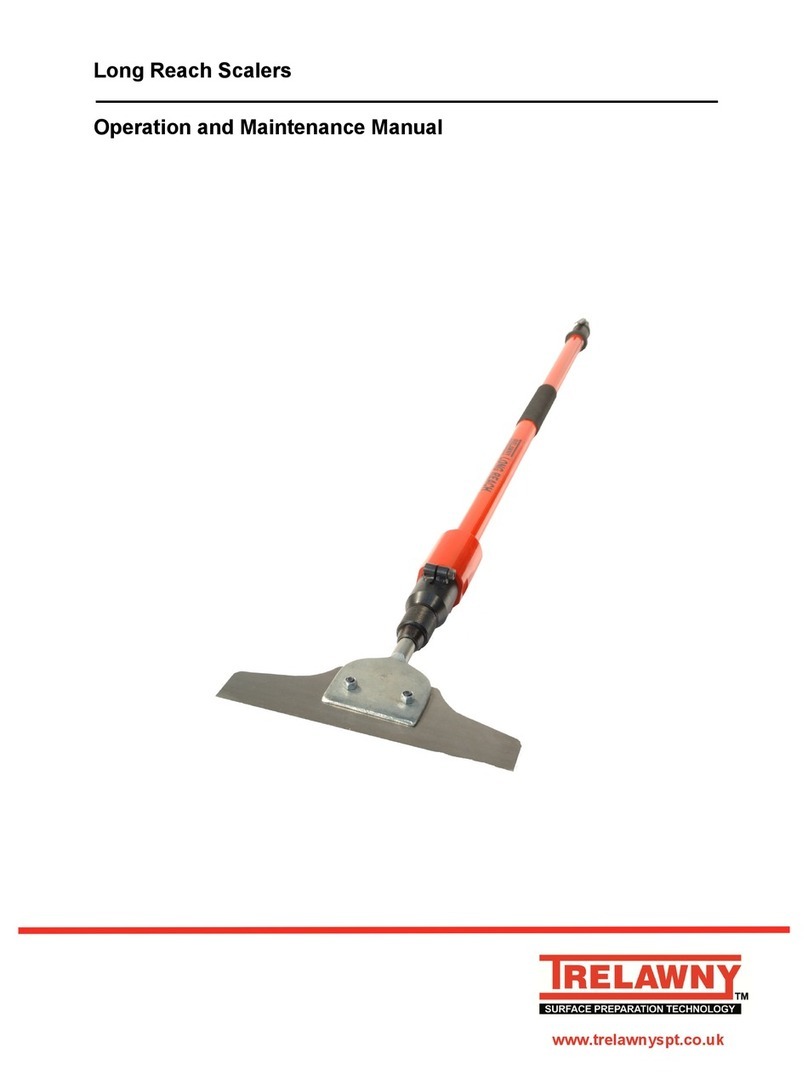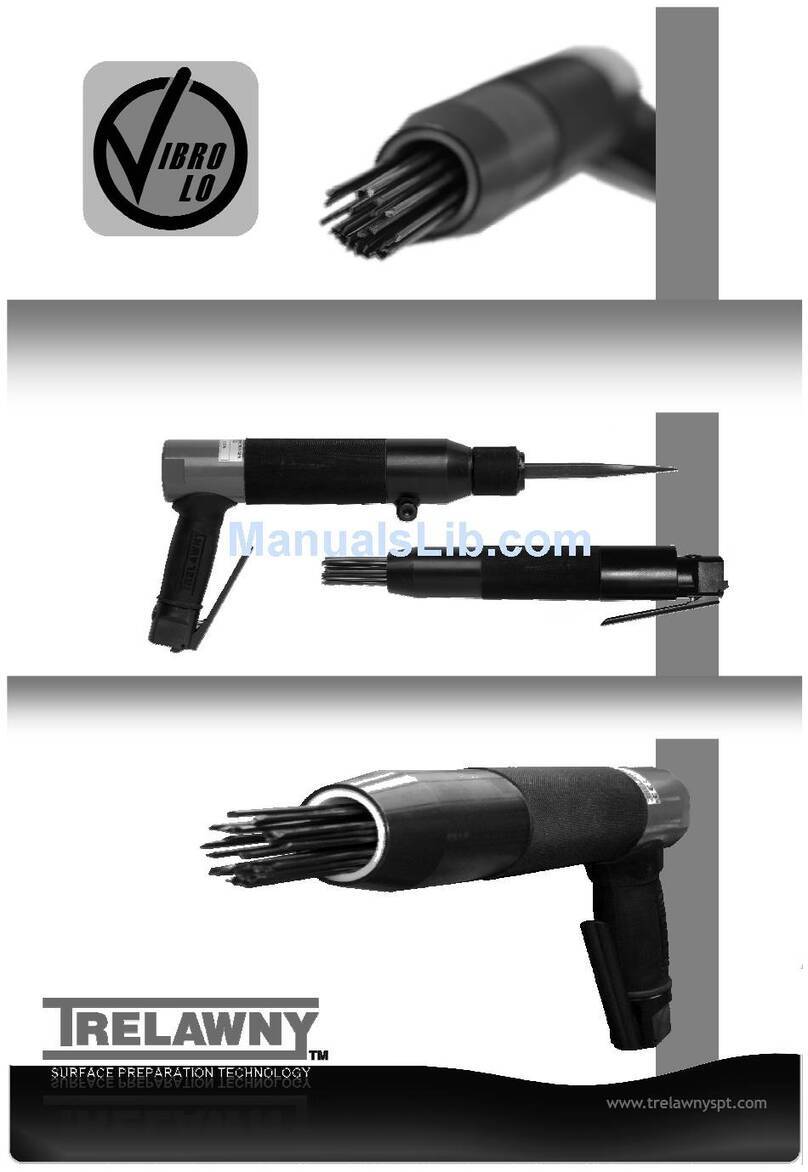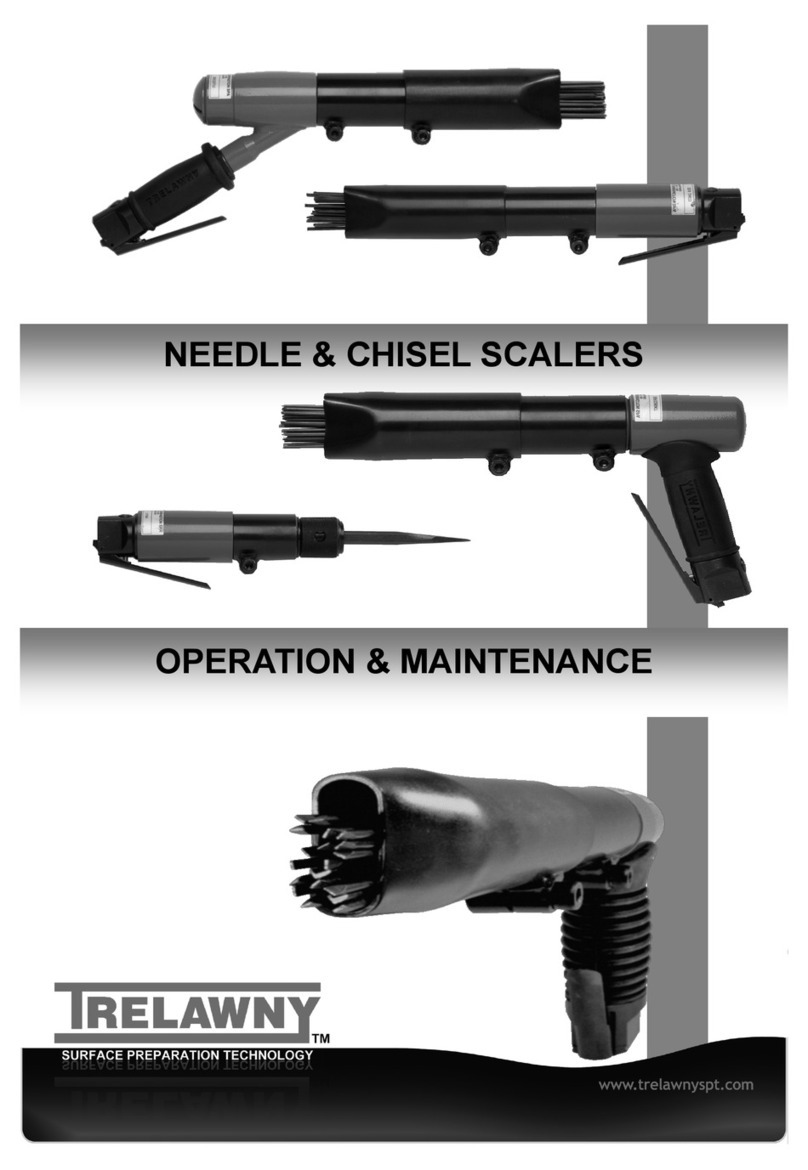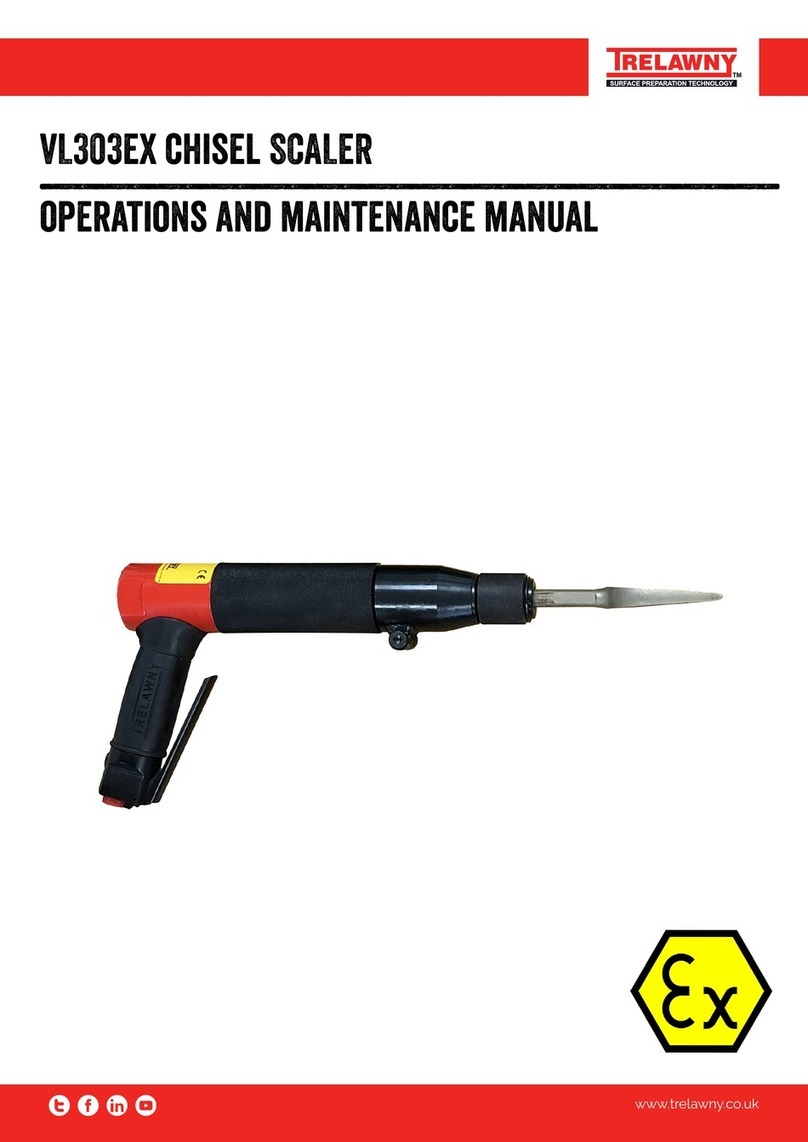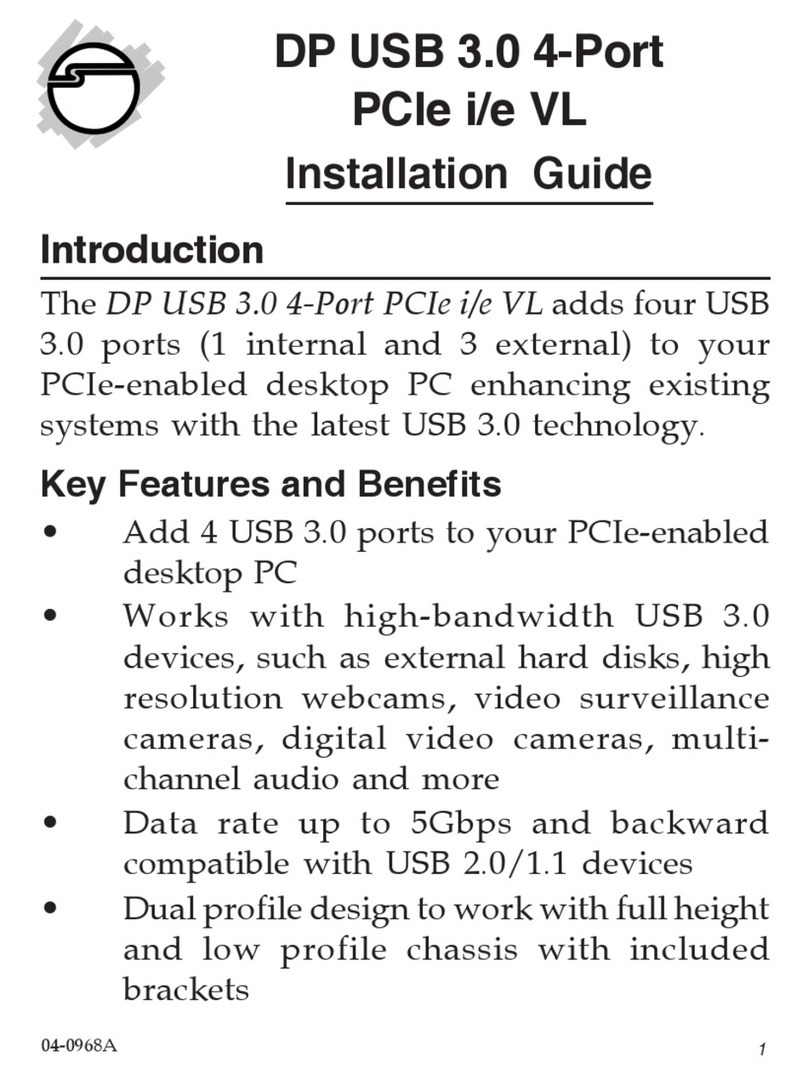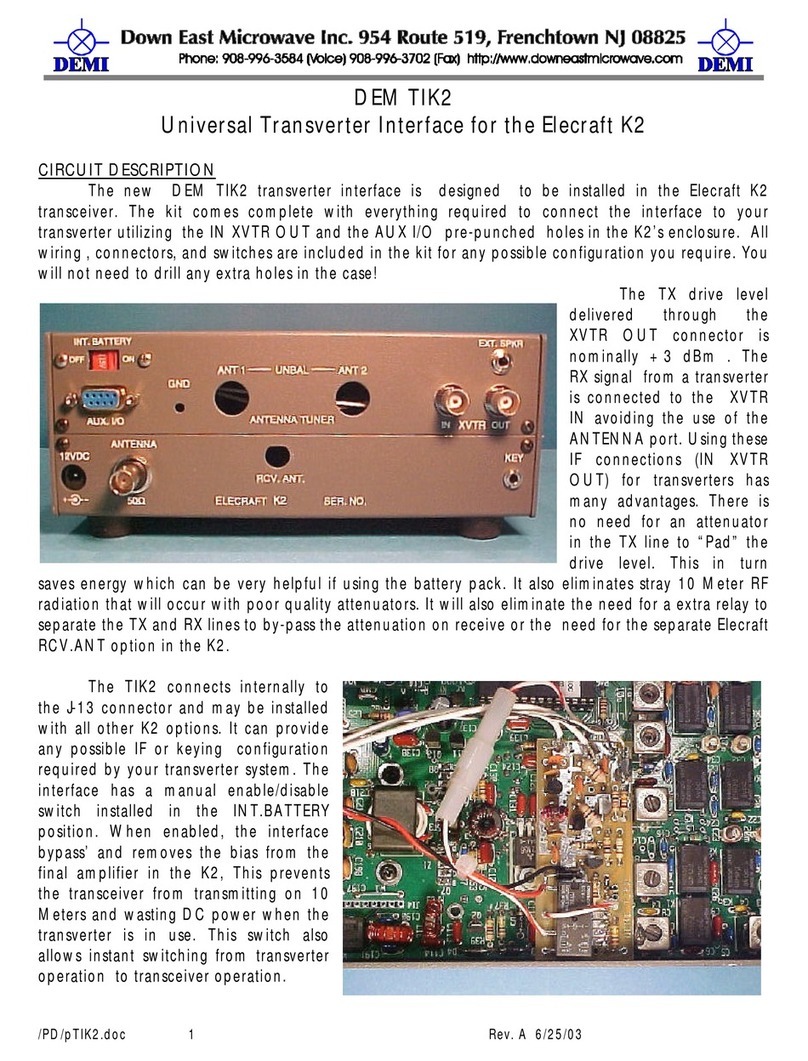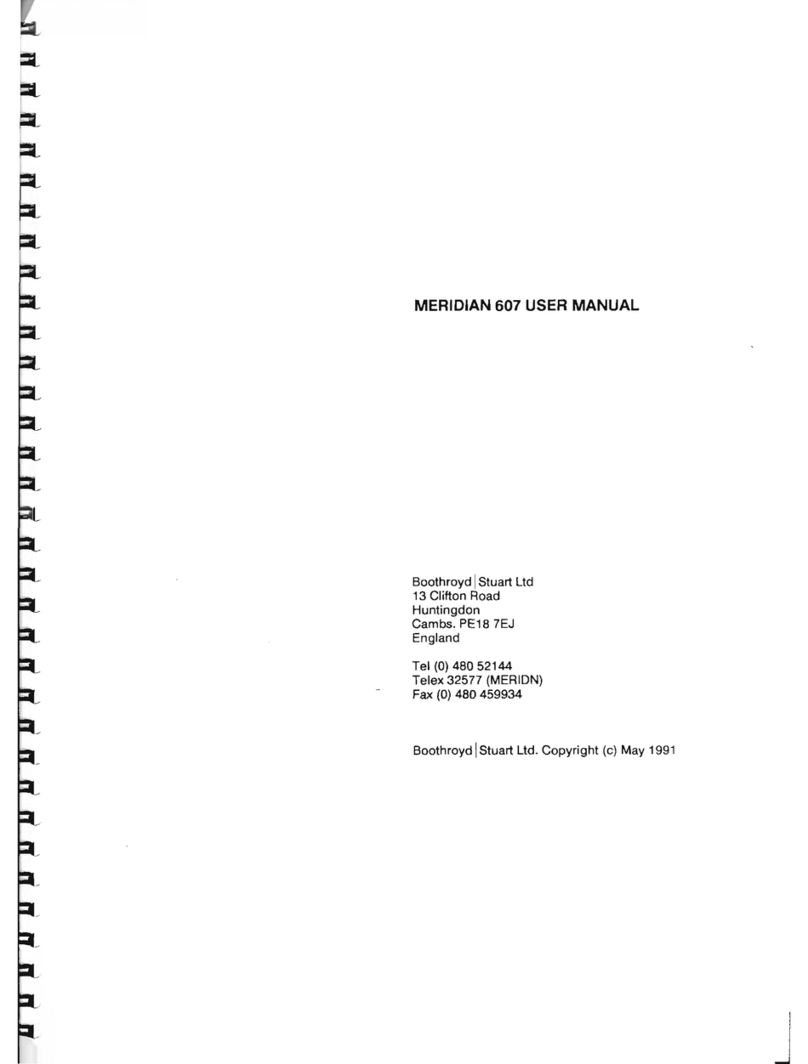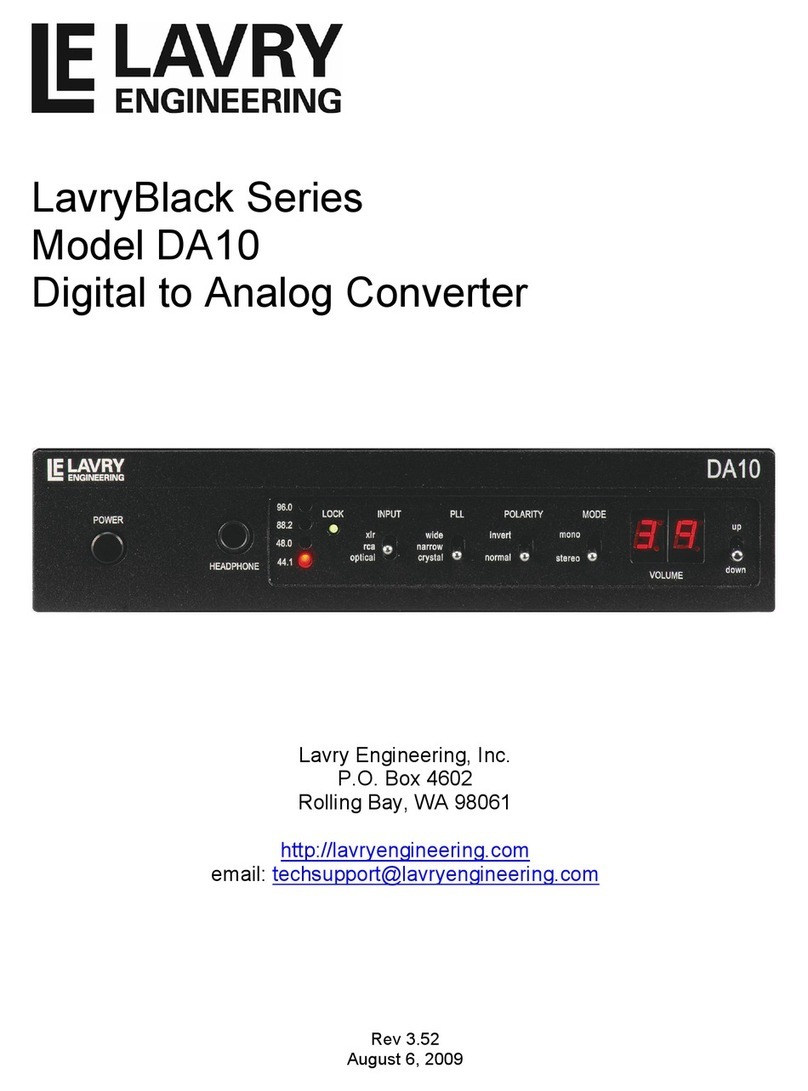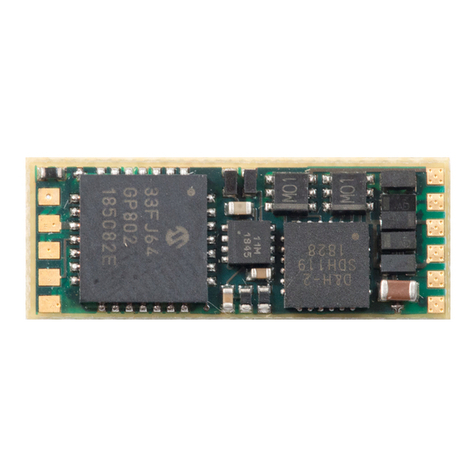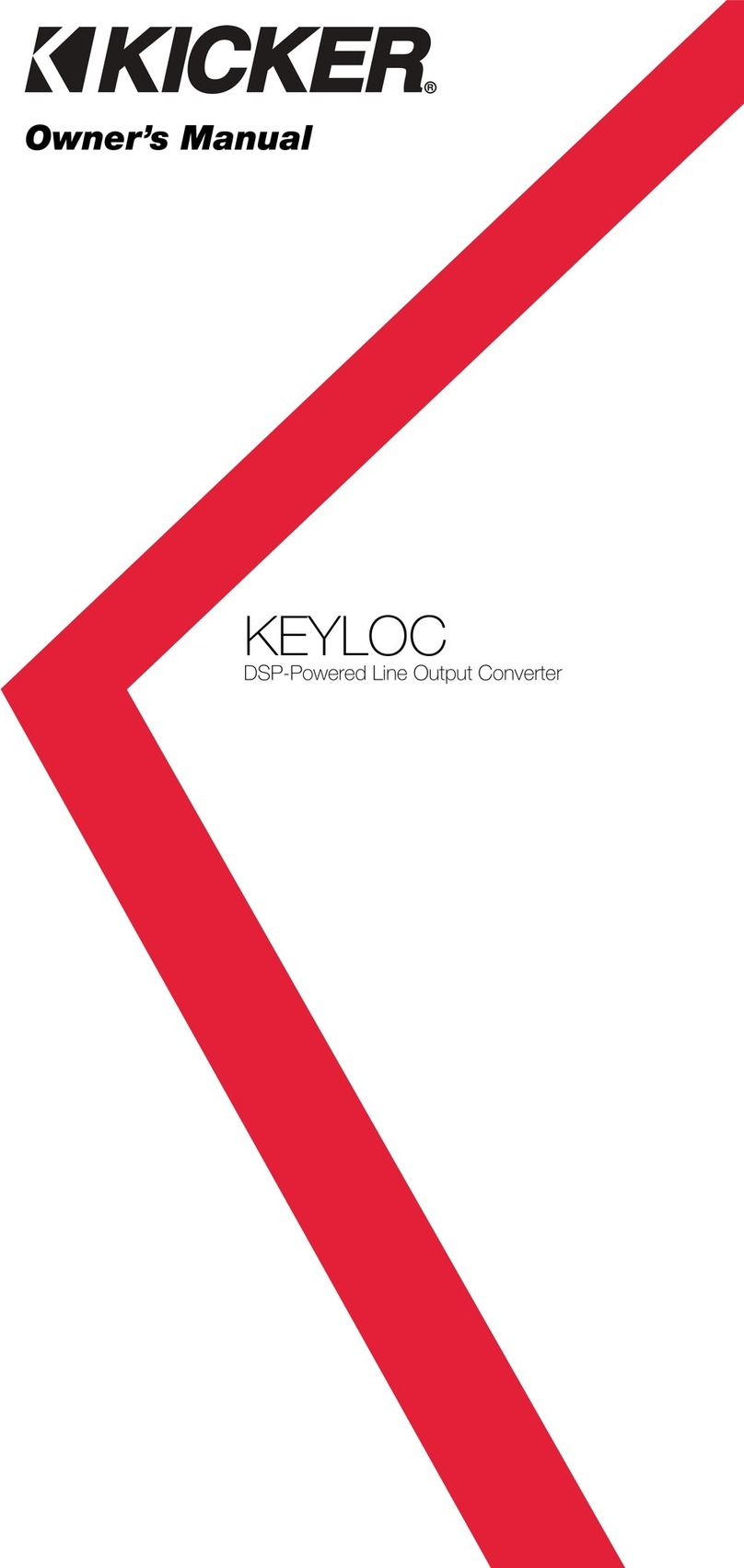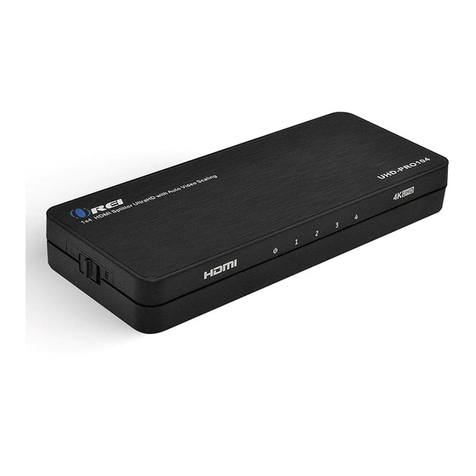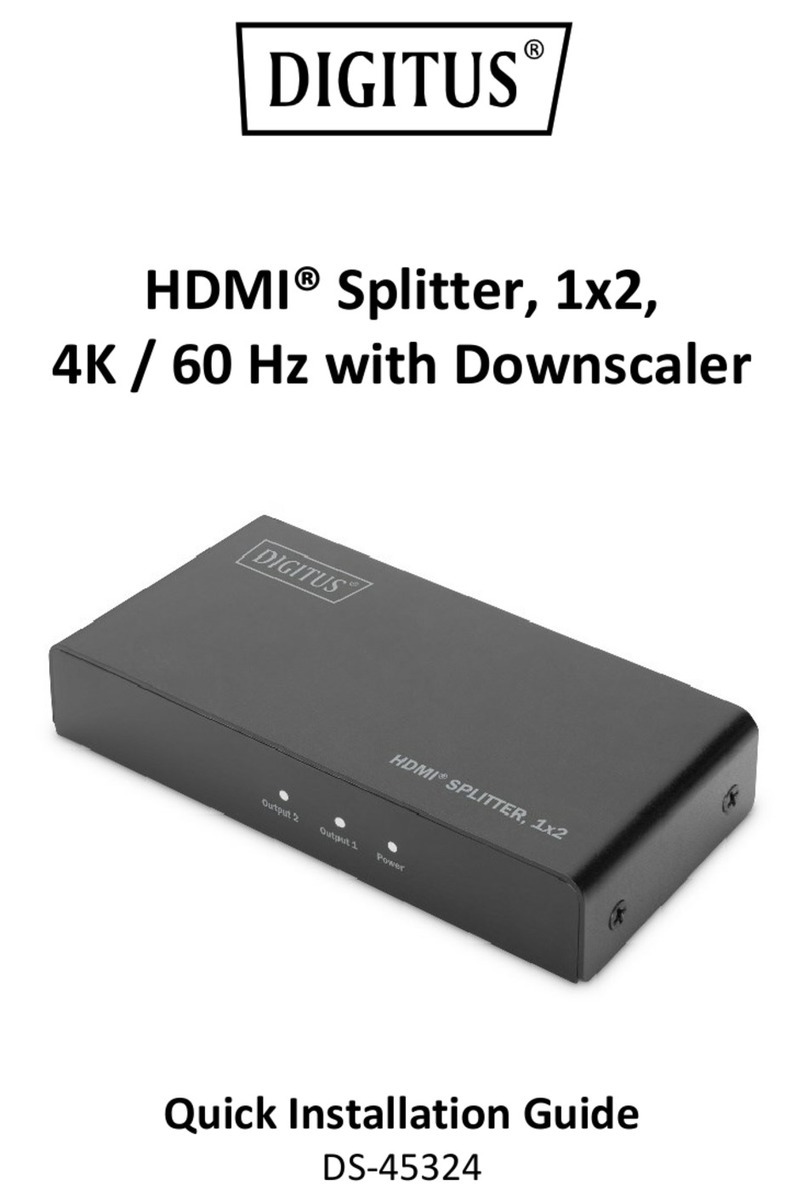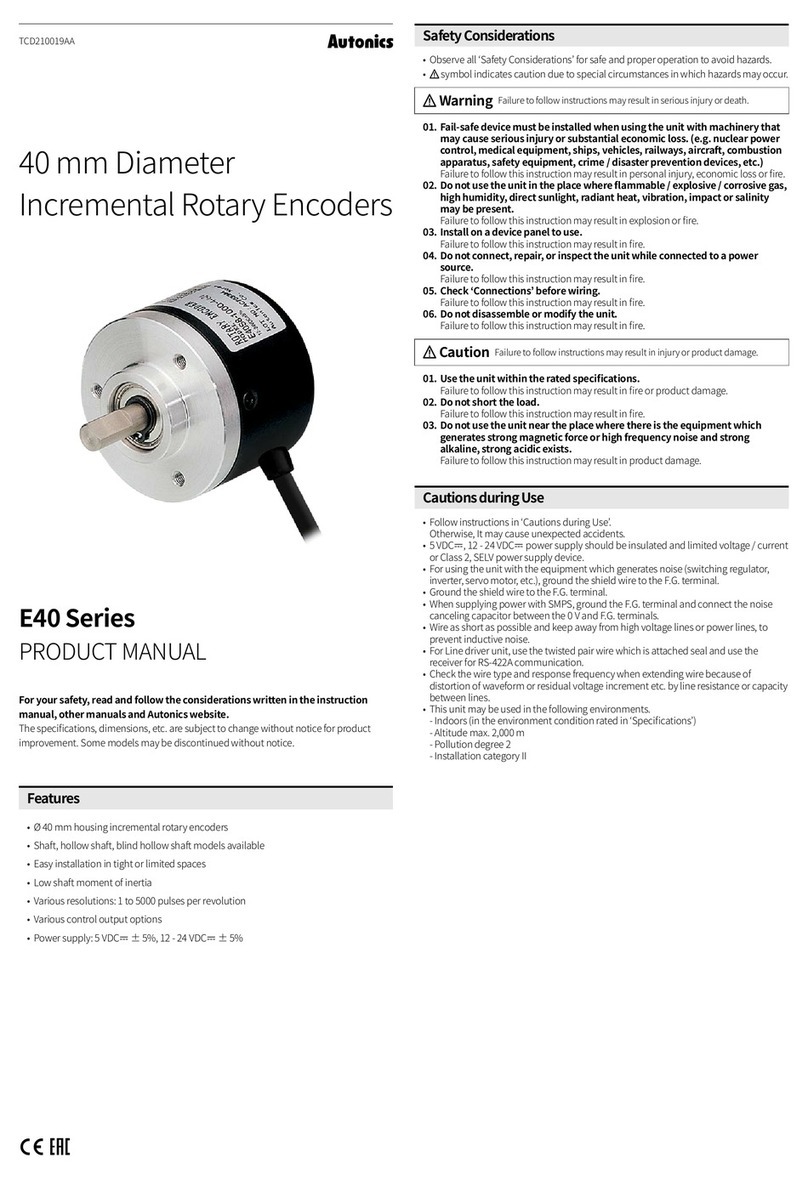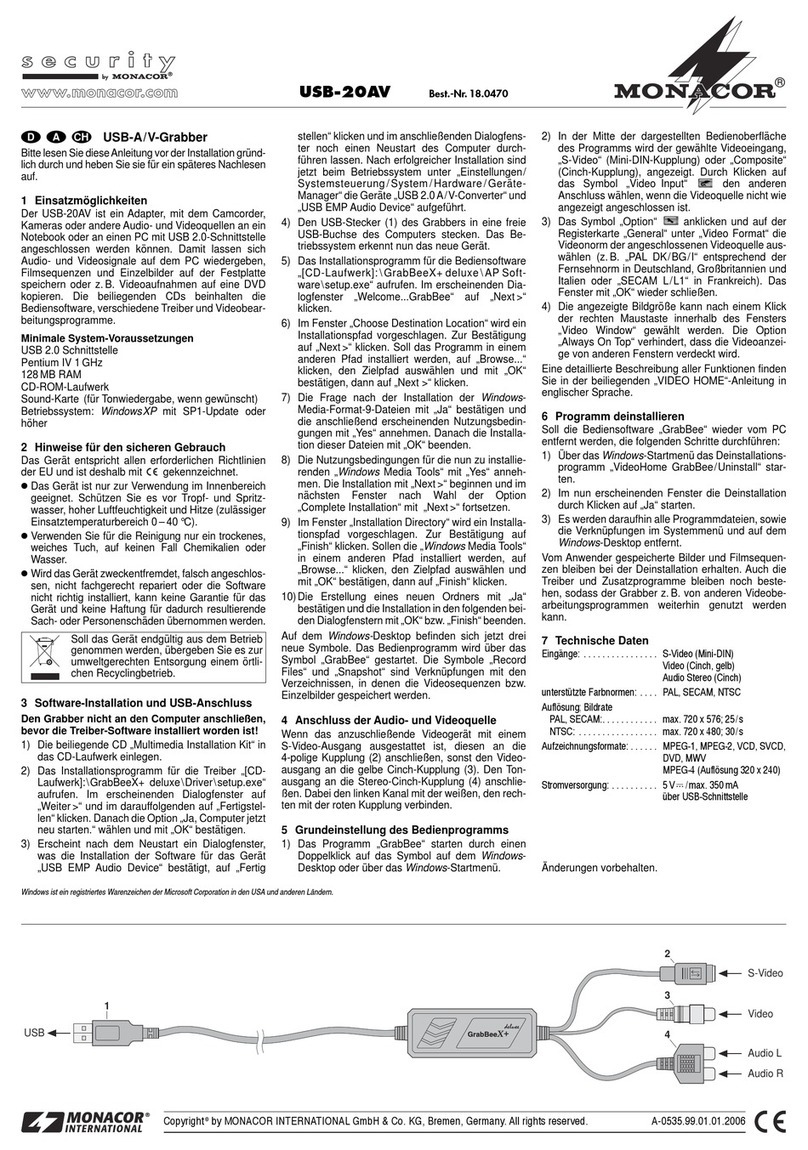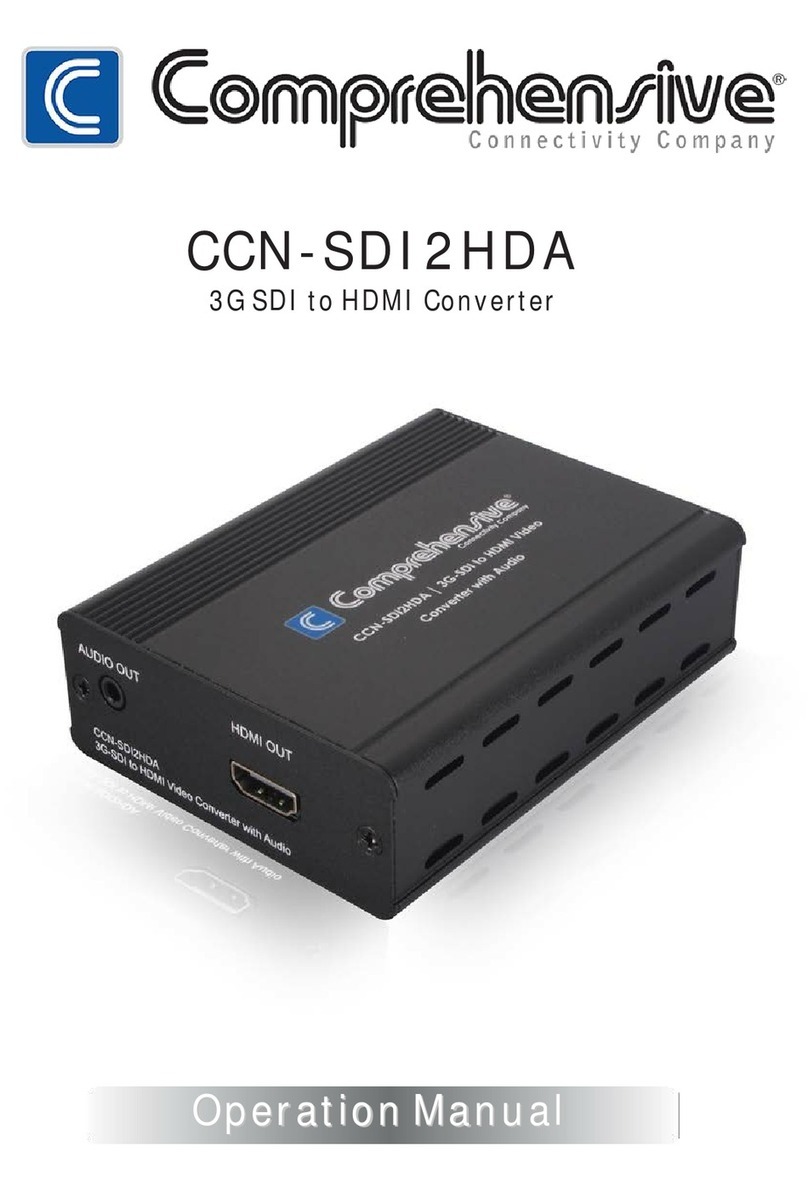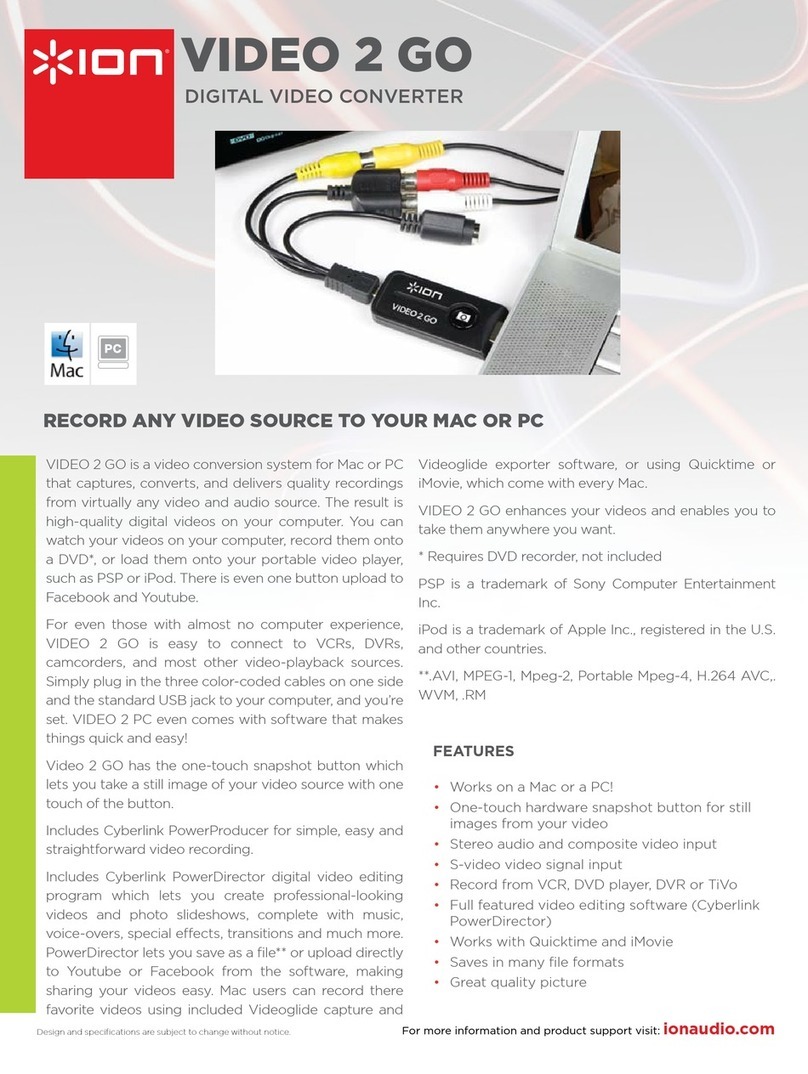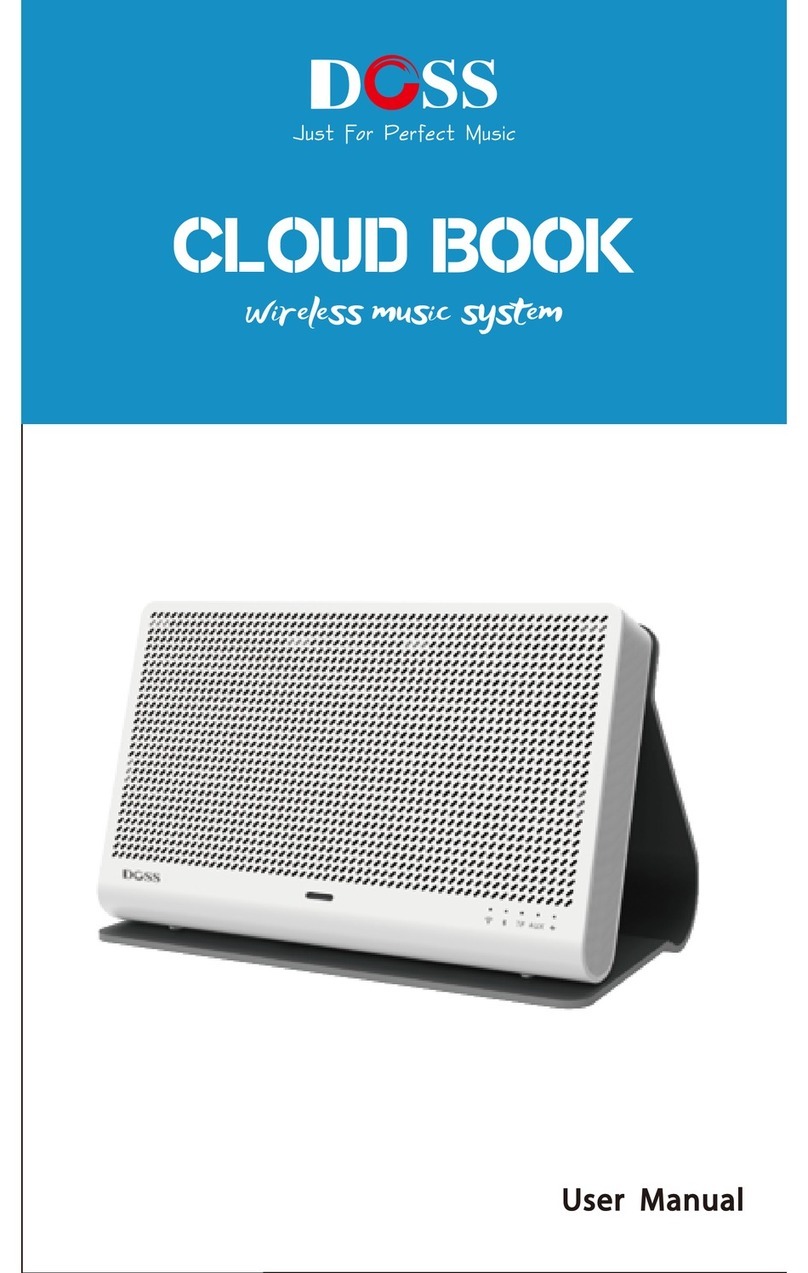Trelawny SF11 Troubleshooting guide

SF11 DECK SCALER
OPERATION & MAINTENANCE

OPERATION
General Information
Thank you for your purchase of the SF11
DECK SCALER.
Before operating the SF11 Deck Scaler this
manual must be read and understood by the
operator if in any doubt ask your supervisor
before using this equipment. Failure to follow
these instructions could result in damage to the
Scaler and/or personal injury.
Trelawny SPT Ltd disclaims all responsibility for
damage to persons or objects arising as a
consequence of incorrect handling of the tool
failure to inspect the tool prior to starting work
for damage or other faults that may influence
the operation or safe working of the tool or
failure to follow the safety regulations listed or
applicable to the job site.
The tool is primarily designed for the removal of
heavy rust paint and scale from ships decks or
heavy steel surfaces.
This tool must not be used in a fixture.
The SF11 Deck Scaler is also available fitted
with economy hardened steel one-piece
pistons or can subsequently be fitted with other
types of cutter heads.
A vacuum shroud attachment is also available
for the containment of air-borne dust.
All versions can be used both indoors and out.
Operators should be familiar with the data
given in the specification section.
Please keep these instructions in a safe and
accessible place.
Safety Preca tions
Do wear Personal Protective Equipment
including safety goggles footwear ear
defenders and gloves. In some environments it
will be necessary to wear facemasks or
breathing apparatus.
Do be aware that this tool is not electrically
insulated.
Do ensure that this tool is lubricated daily.
Do be aware that this tool can create dust and
flying debris.
Do be aware of others working around you.
Do keep hands and clothing away from moving
parts.
Do store this tool in a secure and dry
environment.
Always observe safe working practices and
local safety regulations at all times.
Do not allow the tool to run unattended.
Do not allow the tool to run continuously whilst
not in contact with the surface being prepared.
Do not modify this tool in any way as this will
invalidate the warranty and could lead to
serious injury.
Do not use this tool in potentially explosive
environments.
Do not drag this tool by the air hose.
Do not use petrol (gasoline) thinners or any
other high flash point solvent to clean the tool.
Please note: Unrestrained hoses can whip if
they become detached.
Ensure that the work place is well ventilated.
Avoid operating engine-powered compressors
in an enclosed area since engine exhaust
gases are poisonous.
Risk of Hand-arm
Vibration inj ry
These tools may cause Hand-arm Vibration
Syndrome injury if their use is not adequately
managed. We advise you to carry out a risk
assessment and to implement measures such
as; limiting exposure time [i.e. actual trigger
time not total time at work] job rotation
ensuring the tools are used correctly ensuring
the tools are maintained according to our
recommendations and ensuring that the
operators wear personal protective equipment
[PPE] particularly gloves and clothing to keep
them warm and dry. Employers should
consider setting up a programme of health
surveillance to establish a benchmark for
each operator and to detect early symptoms
of vibration injury.
We are not aware of any PPE that provides
protection against vibration injury by
attenuating vibration emissions.
See ‘Technical Specifications’ section for
vibration emission data.
Further advice is available from our Technical
Department.
We strongly advise you to visit the
Health & Safety Executive website
http://www.hse.gov.uk/vibration
This site provides excellent advice and
information on HAV and it includes a Hand-
arm Vibration Exposure Calculator that is
easy to use to work out the daily vibration
exposure for each of your operators
Pre-Start Check
Air Supply:
The compressed air must be free from water or
contamination. Always clear the air hose before
connection to the tool.
Ensure that no moisture (condensation) is
present. Ensure that a minimum 19mm (3/4")
bore airline is used and that all couplings are
tight and secure. If possible try to limit the
length of airline to 33 ft. (10 metres)
(Air consumption is shown under Technical
Specifications at the end of these
instructions).
Where extra length airline is necessary each
additional 50 ft. (15 metres) of airline used will
drop the pressure at the tool by approximately
3 psi.
Correct operating pressure for this tool is 6.2
bar (90psi)
Do not let the operating pressure fall below
5.5bar (80p.s.i.) or rise above 6.9bar (100 psi)
absolute maximum.
The compressor must be able to supply a
minimum of 47 lps (100cfm)
In particularly cold weather it is recommended
that a proprietary anti-freeze lubricating oil is
used.
Note: A vacuum shroud is not available on the
standard SF11. This can only be fitted to Heavy
Duty version.
Starting work
Prior to operating the tool check: -
That all fittings are secure free from leaks and
that air hoses are in good condition.
That all parts of the tool are fully screwed
together and secure if in any doubt ask
your supervisor before using this
equipment.
That a liberal amount of lubricant has been put
into the air inlet of the tool. (See
recommended lubricants)
Safe use of this tool requires a solid stance and
secure foothold; the operator must adopt a
firm and stable position at all times.
Remove the lifting pin from the bottom of the
handle to release the handle refit in to the
block-lifting bracket to prevent its loss. Never
run the tool with the handle fastened to the
main body. The most efficient scaling action is
to move the tool back and forth until the desired
finish has been achieved. Never run the tool
continuously in the same place as this will
severely mark the surface and may cause
cutter head damage.
To operate the tool simply turn the ball valve so
that he lever is in line with the handle. If the tool
is new optimum performance will be achieved
after 15mins “running in” of the brush seals
(29). Complete a small area noting the
performance; stop the machine inspect the
finish produced. To switch off, simply return
the ball valve lever to 90° to the handle whilst
continuing to move the tool back and forth.
Handled correctly the SF11 Deck Scaler will
work quickly and efficiently. Gloves and
personal protective equipment must be worn
when using this tool. The tool will ride
irregularities of up to 5mm (1/4”). Anything
greater will risk cutterhead damage. Care must
be taken to avoid damaging or tripping over the
air hose. Once the task is completed return
handle to the upright position and insert the
handle-locking pin (11) for transportation.
Servicing
Only a competent person in a suitably
equipped workshop must carry out
maintenance.
Disconnect the tool from the air s pply
before carrying o t any of the following
operations.
Dismantling
Clean all debris from the exterior of the tool.
Head Removal – Taper Fit Pistons
Lay the machine down on its side. Unscrew
and remove screwed cap (25). Remove spring
cap (27) and spring (26). From the bottom of
the unit push on the cutter head and remove
the piston assembly. Repeat for all other
cylinders. Place the head removal washer
between the cutter head and the cylinder place
cylinder assembly on a flat solid surface with
the cutter head upper most insert the removal
pin into the cutter head hole so that it rests on
the end of the piston. Wearing safety glasses
deliver a sharp blow to the head of the pin with
a medium sized hammer and the cutter head
will be released from the piston.
Piston and Cylinder removal One Piece
Pistons
Unscrew and remove screwed cap (25).
Remove spring cap (27) and spring (26) from
the bottom of the scaling head push up and
remove the piston (30) cylinder (28) and brush
seal (29) as an assembly. Repeat for all other
cylinders.

SERVICING
FAULT CAUSE ACTION
Machine bounces in use Air pressure to high. Ensure that the air pressure is set at 90psi. (6.3bar).
If the air pressure cannot be controlled close off the SF11
on/off valve slightly until the machine runs smoothly.
Machine performance slow Worn Cutter Heads Replace Cutter Heads (Cutter Head life is approximately
100hrs use)
Machine drags on deck or floor Insufficient air supply Ensure that the compressor can supply at least 100cfm (free
air) at 90psi. The SF11 Deck Scaler requires 70cfm
Hose bore to small Ensure that the hose bore is 3/4” (19mm).
Hose run to long Each 50 ft. (15 metres) of airline used will drop the pressure
by approximately 3 psi.
Worn Pistons and/or cylinders. Replace piston and cylinders
If the problem has not been cured by any of the above actions contact your local dealership or agent for assistance.
Tro ble Shooting
main handle (14). Insert the bolt (9) and fit a
washer (8a) and nut (8). Fit the handle-locking
pin (11). Select a 13mm A/F spanner to suit (8)
and a 6mm A/F Allen key to suit caphead
screw (9). Tighten both nut and bolts (8) & (9)
ensuring that the pin hole is central and the
locking pin can be removed and inserted easily.
Machine storage
Short period storage: p to 3months.
Clean the outside of the machine and inspect
the cutter heads for wear replace any worn
parts as required. Insert a liberal quantity of air
tool oil through the air inlet and run briefly to
ensure that internal components are coated
with oil. Cover the machine to protect it: Store
the machine in a dry place.
Long period storage: over 3months
Clean outside of machine inspect the cutter
heads for wear; replace any worn parts as
required. Remove any build up of material from
the cutter head area. Insert a liberal quantity of
air tool oil through the air inlet and run briefly to
ensure that internal components are coated
with oil. Lubricate the exposed part of the
piston and cylinder. (See recommended
lubricants) Cover the machine to protect it:
Store the machine in a dry place.
After a further 3 months have elapsed insert oil
into the air inlet as previously described.
When next used continue as per “Starting work
section”.
Machinery Directive
Information
This tool has been designed and produced in
accordance with the following directives:
2006/42/EC Machinery Directive
and applicable harmonised standard:
EN ISO 1 1148-4:2010
If your company has any problem with our
products or would like to discuss the possibility
of an improvement being made to them then
please do not hesitate to contact us. Your
comments are both important and appreciated.
The company operates a policy of continuous
product development and refinement and
therefore reserves the right to change technical
specifications and product designs without
giving prior notice.
All rights reserved. Any unauthorised use or
copying of the contents or part thereof is
prohibited. This applies to trademarks model
denominations part numbers and drawings.
Use only genuine Trelawny spares. The use
of non-Trelawny spare parts invalidates the
warranty.
Assembly of Scaling Head
Removal all traces of oil from screwed cap and
cylinder block threads. Select a cutter head/
piston/cylinder/brush seal assembly and apply
a few drops of air tool oil to the top of the piston
and fit into the body (30) repeat with the other
assemblies. Fit spring (26) into a screwed cap
(25) and fit spring cap (27) into screwed cap as
shown in the service layout. Apply a small bead
of Loctite 243 (Threadloc) or its equivalent to
the first two threads of the spring cap and
screw down by hand fully tighten the screwed
cap using a suitable spanner to a torque of
81.5 Nm (60 lb/ ft).
S b-frame to Scaling Head
Align mounting holes on sub-frame (22) with
anti-vibration pad (21) studs and fit as shown in
service layout. Fit washer (20) and locknut (19)
to both studs and fasten both nuts down to a
torque of 40lb ft
Wheel to S b-frame
Slide wheel (23) onto sub-frame axle fit washer
(20) and insert a new split pin (24) into the hole.
Separate legs on split pin and bend round with
pliers or otherwise. Repeat on the other wheel.
Handle to S b-frame
Fit washer (17) to bolt (16) and align all holes
though chassis and anti-vibration mountings
(18) guide the bolt through until it appears at
the other end. Fit washer (17) to threaded end
of bolt and fit nut (15). To ensure that the sub-
frame does not twist or buckle through over
tightening of the nyloc nut (15) tighten so that
not more than 3/8” (10mm) of thread it
protruding from the nyloc nut (15). Select a
13mm A/F spanner to suit (8) and a 6mm A/F
Allen key to suit caphead screw (9). Slacken off
both bolts (9) and nuts (8) align the lifting plate
(10) to the lifting block (12) and insert the
locking pin (11). Ensure that the pin hole is
central and the locking pin can be removed and
inserted easily adjust as necessary.
Ball Valve Mo nting
Fit one of the two u-bolts (3) around ball valve
(6) and through bracket (4) so that the ball
valve is in line with the handle tube. Guide the
u-bolt (3) into holes in the mounting flange so
that the ball valve is in line with the handle
tube. Fit two nuts (5) finger tight to hold the unit
in place. Repeat with the second u-bolt and
bracket. Align the ball valve handle with the
main handle (14). Select a 13mm A/F spanner
and fasten evenly the four nuts (5) until the
valve is secure.
Lifting Plate
Align holes in the lifting plate with the holes on
that of the lifting plate flange ensuring that the
position of the lifting plate (10) is central to the
Wheel removal
Lay tool on side. Close the split pin (24) and
remove the pin remove washer (20) and slide
the wheel (23) from the axle.
Handle Assembly from S b-Frame
Remove locking pin (11) to free handle. Lay
tool down with hoses uppermost. Unscrew the
connector on the hose (7) from the adaptor
nearest to the scaling head. Select two 15/16”
A/F spanners to fit bolt (16) and nut (15).
Unscrew and remove both nut (15) and washer
(17) withdraw bolt (16) and washer (17).
S b-Frame from Scaling Head
Repeat the above then select a 3/4” A/F
spanner and unlock nut (19) unscrew nut and
remove both nut and washer (20). Repeat for
other side.
Ball Valve from mo nting
Unscrew hose fittings from ball valve (6)
unscrew 4 nuts (5) and remove u-bolts (3) and
mounting brackets (4).
Lifting plate from Handle Assembly
Select a 13mm A/F spanner to suit nut (8) and
a 6mm A/F Allen Key to suit cap head screw
(9) and unlock screw (9). Remove washer (8a)
and repeat for other screw.
Assembly
Ensure all parts are clean and that all internal
parts have a film of air tool oil unless specified
otherwise. Avoid lubricating oil contaminating
the threads of the body and the screw cap.
These will require securing with a thread-
locking adhesive. Replace any parts that show
signs of wear. If the tool has been fully serviced
it is recommended to change anti-vibration
pads (18) and (21).
Piston, Cylinder and Br sh Seal - One piece
pistons
Fit piston (30) into cylinder (28) as shown in the
service layout. Fit new brush seal (29) over
piston and into the recess on the cylinder.
Taper Fit Head Pistons
Ensure that all traces of oil/grease are
removed from the new cutter head taper and
piston taper using a suitable oil free solvent.
Fit the piston into the cylinder as shown in the
service layout. Fit a new brush seal into the
cylinder recess. Select a cutter head and
place on to the taper of the piston. Place the
assembly on to a solid flat surface and with
the cutter head uppermost deliver a sharp
blow with a soft faced hammer to seat the
cutter head onto the piston taper.
(The use of a hard faced hammer will damage
the tungsten carbide inserts).

EXPLODED VIEW

SERVICING contin ed
Trelawny SPT Ltd
Trelawny House 13 Highdown Road Sydenham Industrial Estate Leamington Spa Warwickshire
CV31 1XT United Kingdom
Telephone: +44 (0)1926 883781 Fax: +44 (0)1926 450352 Email: sales@trelawny.co.uk
Website: www.trelawnyspt.com
© TSPT UK 2009 Part No: 735.0110 issue 4
SURFACE PREPARATION TECHNOLOGY
Technical Specifications
Item No Part No Description Item No Part No Description
2 826.5004 Adaptor 3/4" BSP 20-24 491.1000 Wheel Assembly (set of 2)
3-5 491.2100 U Bolt Assembly (set of 2) 25 615.5341 Screwed Cap
6 828.1000 Ball Valve 26 712.5301 Compression spring
7 719.0750 Armoured Hose Assembly with Couplings 27 615.5361 Spring Cap
8-12 491.3000 Lifting Bracket Assembly 28 613.5301 Cylinder
11 490.2100 Locking Pin (set of 2) 29 614.5301 Brush Seal
13 490.0100 Handle Grip (set of 2) 30 612.5301 Piston (Taper fit)
14 422.0110 Handle including grips 31 426.5351 Cruciform cutter head – (Taper fit)
15-17 491.2000 Handle Mounting Assembly or 606.5303 Beryllium cutter head – (Taper fit) –spark resistant
18 490.1000 Rubber Handle Mounting
19-21 491.0100 Rubber Cylinder Block Mtg Assembly (set of 2)
22 440.0130 Sub Frame NOT SHOWN
437.0100 Vacuum Shroud assembly
731.0120 Polyurethane seal
Parts list
Risk of Hand Arm Inj ry
Because of various factors the range of vibration emission during intended use of this tool is expected to be between 5.8m/s
2
– 8.1m/s
2
for this Scaler.
The vibration is dependent on the task the operators grip and the feed force employed etc.
Noise level measured in accordance with: EN ISO 15744: 1999
Vibration measured in accordance with: EN ISO 28927 and EN ISO 20643
(K) Equals the factor of uncertainty which allows for variations in measurement and production.
Vibration data figures are tri-axial which gives total vibration emission.
*In general all vibration values are considered to be –0% +40% (k = factor of uncertainty)
Trelawny SPT Ltd operates a policy of continuous product development and refinement and therefore reserves the right to change technical specifications
and product designs without giving prior notice.
Description Metric Imperial
Piston diameter 27mm 1.06”
Piston length 89mm 3.50”
Stroke 26.5mm 1.04”
Blows per minute 2300 x 11
Air pressure - (3/4”BSP Air Inlet) 6.2 bar 90psi
Air consumption 33 lps 70cfm
Length (handle lowered) 1300mm 51.2”
Height (Handle raised) 1230mm 48.4”
Work head dimensions 285mm (11.2”)L x 150mm (5.9”)W x 180mm (7.1”)D
Weight 37.2kg 82lbs
Noise level db(A) LpA 103.1
LwA
Vibration (AEQ) at the Handle Bar* a=5.8 m/s
2
(K= +40% -0%)
113.1
Cutting width to edge 15mm 0.59”
Cutting width 252mm 9.9”
Table of contents
Other Trelawny Media Converter manuals
